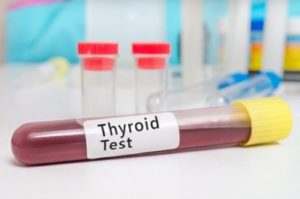3. Blood tests for hypothyroidism and hyperthyroidism
The thyroid hormone family
There are numerous thyroid hormones. Symptoms of hypothyroidism may be related to imbalance in these different hormones. This makes proper lab testing for hypothyroidism much more complex than only looking at TSH. [8]

There are two main forms of thyroid hormone, T4 (thyroxine) and T3 (triiodothyronine). T3 is the stronger active form. T4 is not totally inactive, but is much weaker compared to T3.
The thyroid gland makes some T3, but mostly T4. T4 has to be converted to T3 outside the thyroid.
Not all T4 is converted into T3. Most is actually converted into reverse T3. Reverse T3 is molecularly the same as T3, but it’s shaped in a different way so it’s inactive.
Additionally, thyroid hormone is carried in the blood bound to protein (thyroid binding globulin). Bound thyroid hormone is inactive. A blood test for total T4 measures all T4. A free T4 blood test shows just how much is free to be active. There is always more bound hormone than free. [9]
If too much thyroid hormone is bound (and therefore inactive) this may cause or exacerbate symptoms of hypothyroidism. [10]
So the three steps necessary to get active thyroid hormone is production, conversion into t3 and freeing it from binding protein.
Thyroid function lab tests:
Thyroid Stimulating Hormone (TSH) – Typical reference range: 0.4 – 4.0 mIU/L
TSH is made by the pituitary gland to tell the thyroid how much hormone to make. Although there is no absolute consensus on what the reference range should be, typically 1.5 to 2.5 is most optimal.
Hypothyroidism can have both a high or low TSH pattern:
High TSH (consider above 2.5) and hypothyroidism symptoms indicate either autoimmune disease or iodine deficiency.
Low TSH (consider under 1.5) and hypothyroidism symptoms indicate poor TSH stimulation from pituitary gland. [11]
Thyroxine (Total T4), Free Thyroxine (Free T4) and Free T3
Total T4 measures both the free and bound T4. A free T4 test measures only the free T4. Free T3 is a measurement of free T3 in the blood. Unlike TSH, these tests are a direct measurement of thyroid hormones. [12]
Low T3 could potentially indicate a problem with thyroid hormone conversion that may not be seen by just testing T4. [13]
Reverse T3
Revere T3 may be high (although it can possibly be normal) on lab tests if someone is converting too much T4 to T3. [14]
T3 uptake
This test helps to see how much thyroid hormone is bound (and therefore inactive) to the protein, thyroid binding globulin (TBG). Low T3 uptake can indicate hypothyroidism, and high T3 uptake can indicate hyperthyroidism. [15]
Thyroid antibody tests
Autoimmune disease is when your bodies own immune system attacks and destroys your own cells. In autoimmune thyroid disease (also called Hashimoto’s thyroiditis) the immune system attacks and destroys the thyroid.
Anti thyroid peroxidase (anti-TPO), and anti thyroglobulin measure antibodies against the thyroid gland. If either are elevated this indicates an autoimmune attack on the thyroid gland.
Medical doctors often do not run these because regardless of result they will prescribe thyroid hormone according to TSH. However, from a holistic perspective, antibody tests help show the cause of hypothyroidism and thus guide treatment.
Thyroid stimulating immunoglobulin (TSI)
This antibody mimics the actions of TSH and stimulates the thyroid to make too much thyroid hormone. High amounts of TSI are associated with Graves disease and hyperthyroidism. In Graves disease all 3 antibodies should be tested.
Other tests for hypothyroidism:
Basal Body temperature
This test for thyroid function was popularized by Broda Barnes and his book “Hypothyroidism: The Unsuspected Illness.” Since thyroid hormone is largely responsible for body temperature, it follows that measuring body temperature may indicate hypothyroidism. Often people with low body temperatures have hypothyroidism symptoms, despite normal thyroid blood tests.
Directions:
Place thermometer by your bed before going to sleep.
Upon waking, place the thermometer under the armpit for a full 10 minutes (oral temperature can be taken instead).
Stay as still as possible. Rest with the eyes closed.
Record temperature for at least 3 days (some sources will say up to 10 days). Menstruating women should do the test on the second, third and fourth day of their period. [16]
Average body temperature should be between 98.0°F and 98.6°F. [17]
Lateral 1/3 of eyebrows
People with hypothyroidism often lose the outer third of their eyebrows.
Achilles heel reflex
Most people know that there is a reflex point just below the knee. When a doctor hits this point with a reflex hammer, it causes the leg to involuntarily move.
We have another reflex point on the Achilles’ tendon. This is the strong ligament on back of the leg, where the leg meets the foot. Hitting the Achilles’s tendon with a reflex hammer should cause the foot to jerk. This is known as the Achilles heel reflex.
People with hypothyroidism often have a diminished Achilles reflex and this is a simple way to indicate possible hypothyroidism.
Just testing TSH is not enough
It is essential to run appropriate thyroid tests. There is no consensus among holistic practitioners which tests are best to run. However expanded panels will usually include, TSH, free and/or total T4, and free T3 as bare minimum. Individual patient circumstances may warrant testing more thyroid labs.
It is also important for each patient to get a copy of their labs and review them personally. Just because a doctor says your labs are all “normal” that doesn’t mean nothing is wrong. Official reference ranges are too large; so all labs should be reviewed with scrutiny.





